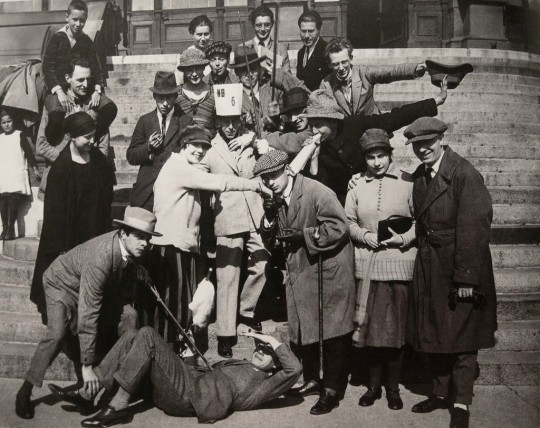#Werner Gräff
Explore tagged Tumblr posts
Text

Unknown photographer. International Congress of Constructivists and Dadaists, Weimar. Summer 1922. Gelatin silver print, 6½×8¾" (16.6 × 22.2 cm). Bauhaus-Archiv Berlin. Top row, from left:
Lucia Moholy, Alfred Kemeny, László Moholy-Nagy. Second row from top: Lotte Burchartz, El Lissitzky, Cornelis van Eesteren, Sturtzkopf.
Third row from top: Max Burchartz (with child on shoulders), Harry Scheibe, Theo van Doesburg, Vogel, Peter Röhl. Front row standing:
Alexa Röhl, Nelly van Doesburg, Tristan Tzara, Nini Smit, Hans Arp.
Front: (left) Werner Gräff, (lying) Hans Richter
6 notes
·
View notes
Text

Cover of Werner Gräff
Here Comes The New Photographer
Berlin 1929
29 notes
·
View notes
Text
Wie wichtig ist die eigene Persönlichkeit als Fotograf?
Wie wichtig ist die eigene Persönlichkeit als Fotograf?
Liebe Freunde der schöneren Fotografie,
wenn ihr in dem Klima der Fotografie etwas werden wollt. Ist eine eigene Persönlichkeit von wesentlicher Bedeutung!
Wenn wir uns umschauen existieren derzeit es nur zwei Arten von Fotografen:
Entweder sind es Arschkriecher oder es keine!
Viele Fotografen versuchen die Persönlichkeiten und Fotografien anderer Fotografen stumpf zu kopieren und zu…
View On WordPress
0 notes
Text
Modernism
Modernism is a philosophical movement that, along with cultural trends and changes, arose from wide-scale and far-reaching transformations in Western society during the late 19th and early 20th centuries.
Photography & Cinema
This entangling of techniques is on full display in the ’20s in the exhibitions Kipho (Kino und Photo), organized in Berlin in the fall of 1925, and Fifo (Film und Foto), which took place in Stuttgart in the early summer of 1929. While Kipho focused more on cinema and photography as industries, Fifo was more artistic in its ambitions. The interdisciplinary crossroads at Fifo included photographers, multidisciplinary artists (Moholy-Nagy, Lissitzky, Richter), historians of architecture (Sigfried Giedion), designers, and typographers (Zwart, Tschichold). Fifo, in spite of its fusional title, presented itself as a photography exhibition with an avant-garde film festival organized by Richter. It was the first exhibition to address the two mediums at the same time. The hanging of certain sections more clearly underscored the link between the two techniques, transcending the distinction between the exhibition of photographs, on the one hand, and the festival of films on the other: the Soviet section, designed by Lissitzky and Sophie LissitzkyKüppers, presented film stills from Russian productions of the ’20s and films in viewfinders alongside photographic prints — thus beginning cinema’s migration into the traditional exhibition space. In the hanging of his section, Moholy-Nagy used a number of resources from film montage, envisioning it as a storyboard. Two publications were printed in conjunction with the exhibition, although neither constituted the official publication: one on photography, Es kommt der neue Fotograf! (Here comes the new photographer!) by Werner Gräff, the other on cinema, Filmgegner von heute — Filmfreunde von Morgen (Film haters today, film lovers tomorrow), by Richter.
1 note
·
View note
Photo

Ver no es simplemente mirar
Raoul Hassmann: (…) Ver no es simplemente mirar apresuradamente. Mirar expresa una direccionalidad…
View Post
2 notes
·
View notes
Photo

Werner Gräff "Here's Come the New Photographer!" Book Cover, Berlin 1929
12 notes
·
View notes